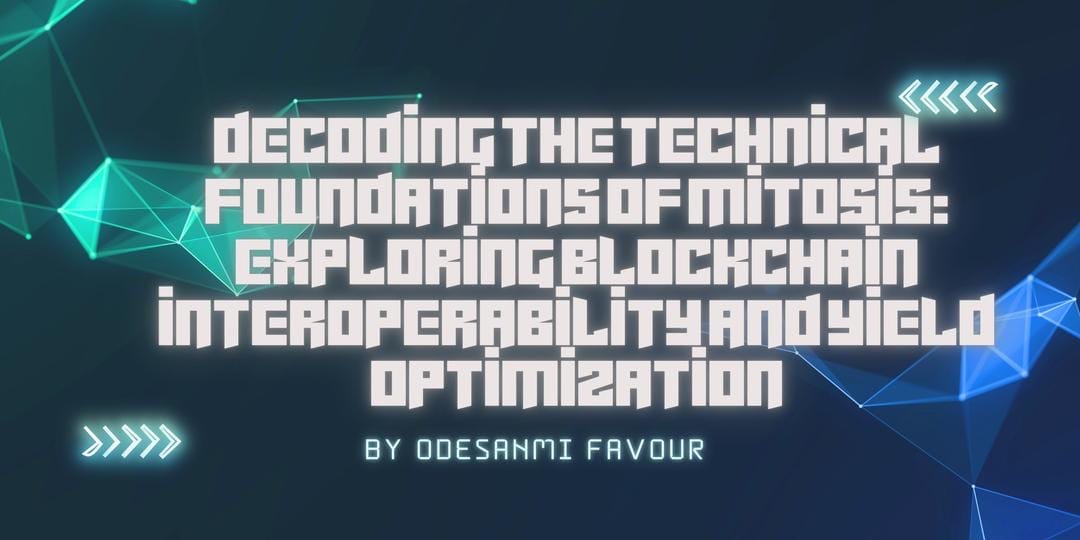Decoding the Technical Foundations of Mitosis: Exploring Blockchain Interoperability and Yield Optimization

Introduction
Imagine a world where your assets can seamlessly flow between blockchains, maximizing returns without the friction of fragmented ecosystems. This is the promise of Mitosis, a project redefining liquidity and yield dynamics in decentralized finance (DeFi). As blockchain technology evolves, interoperability and capital efficiency have become critical challenges. Mitosis tackles these head-on, offering innovative solutions like ecosystem-owned liquidity (EOL) and yield optimization strategies such as the Straddle Vault.
In this article, we would explore
1. The Backbone of Mitosis: Blockchain Interoperability
2. Yield Optimization: The Straddle Vault and Beyond
3. Why Mitosis Matters: A New Paradigm for DeFi
The Backbone of Mitosis: Blockchain Interoperability
1. Secure and Seamless Cross-Chain Asset Transfers
Mitosis enables users to move assets between blockchains without facing the usual technical complexity or cost burdens.
The blockchain ecosystem has witnessed rapid growth, with various networks emerging to cater to specific needs. However, this fragmentation has created a pressing need for seamless interaction between different blockchain networks. Cross-chain asset transfers have become a crucial component in achieving blockchain interoperability, enabling users to access multiple ecosystems and utilize their assets more efficiently.
The Importance of Cross-Chain Asset Transfers
Cross-chain asset transfers allow users to move digital assets between different blockchain networks, enhancing liquidity, flexibility, and user experience. This process is facilitated by blockchain bridges, smart contracts, and cryptographic techniques, ensuring secure and efficient transfers.
For Example: A trader holding DAI on Ethereum can shift it to Optimism via Mitosis, bypassing centralized bridges and avoiding gas inefficiencies.
2. Ecosystem-Owned Liquidity (EOL) as a Community-Driven Solution
Unlike traditional liquidity models, EOL allows users to co-own and manage liquidity pools, aligning incentives across the ecosystem.
In the rapidly evolving landscape of decentralized finance (DeFi), innovative solutions are emerging to address the challenges of liquidity provision. Ecosystem-Owned Liquidity (EOL) is a community-driven approach that empowers communities to collectively own and manage liquidity, promoting decentralization, sustainability, and community involvement.
The Benefits of EOL
EOL offers several benefits, including community control, sustainability, and incentive alignment. By allowing communities to control their liquidity, EOL promotes decentralization and reduces reliance on centralized entities. This approach also incentivizes long-term liquidity provision, fostering sustainable ecosystem growth and reducing the risk of liquidity crises.
How EOL Works
EOL solutions typically involve community governance, liquidity provision, and incentive mechanisms. Communities establish governance structures to manage EOL, making decisions on liquidity provision and asset allocation. Community members contribute assets to the liquidity pool, which is then managed collectively. Incentive mechanisms, such as token rewards or fees, encourage participation and liquidity provision.
For Example: Users pool USDC into an EOL vault, which then supports lending protocols on multiple chains, returning yield directly to contributors.
Yield Optimization: The Straddle Vault and Beyond
1. Dynamic Asset Allocation Based on Market Signals
The Straddle Vault smartly reallocates funds across DeFi strategies based on changing market conditions, reducing risk and enhancing yield.
In the rapidly evolving landscape of decentralized finance (DeFi), yield optimization has become a crucial aspect of investment strategies. One approach that has gained significant attention is dynamic asset allocation based on market signals. This strategy involves adjusting asset allocations in response to market trends and signals, aiming to maximize yields while minimizing risks.
Understanding Dynamic Asset Allocation
Dynamic asset allocation is an investment strategy that involves actively adjusting the allocation of assets in a portfolio based on market conditions. This approach differs from traditional static allocation strategies, which often rely on fixed asset allocations. By dynamically adjusting asset allocations, investors can respond to changing market conditions, capitalize on emerging opportunities, and mitigate potential losses.
For Example: When yield on Arbitrum spikes due to a new liquidity mining campaign, the vault automatically shifts more assets there to capture returns.
2. Power in Numbers: Leveraging Collective Liquidity
By pooling resources through EOL, Mitosis unlocks opportunities that would typically require high capital or institutional access.
In the world of finance, liquidity plays a crucial role in facilitating transactions and driving market efficiency. Collective liquidity, in particular, has the potential to unlock new opportunities and benefits for participants. By pooling resources and sharing liquidity, individuals and institutions can tap into a larger, more diverse pool of assets, reducing risks and increasing potential returns.
For Example: A group of small investors can collectively participate in a high-yield strategy on zkSync, previously accessible only to whales.
Why Mitosis Matters: A New Paradigm for DeFi
1. Solving Fragmentation for a Unified DeFi Experience
Mitosis abstracts the complexities of operating across chains, enabling a seamless experience similar to Web2 finance.
The DeFi ecosystem has experienced rapid growth, with numerous protocols and platforms emerging to cater to diverse needs. However, this growth has also led to fragmentation, making it challenging for users to navigate and interact with different DeFi ecosystems seamlessly. Solving fragmentation is crucial for creating a unified DeFi experience.
For Example: Developers can build on top of Mitosis’s SDK to offer users multi-chain services without requiring them to understand the underlying tech.
2. Community Ownership as a Catalyst for Growth
Mitosis redefines governance by allowing token holders to shape the protocol’s liquidity deployment and yield strategies.
The Benefits of Community Ownership
Community ownership offers several benefits, including increased engagement, improved decision-making, and enhanced sustainability. When communities have a stake in the ownership and decision-making process, they are more likely to be engaged and invested in the success of the protocol or platform. Community ownership can also lead to more informed and decentralized decision-making, as community members bring diverse perspectives and expertise to the table.
For Example: The community votes to reallocate liquidity from a declining farm on Fantom to a new yield opportunity on Linea.
Conclusion
Mitosis is more than just another DeFi project—it’s a bold step toward solving some of blockchain’s toughest challenges. By combining interoperability with yield optimization, Mitosis enables seamless asset movement and maximizes returns. The ecosystem-owned liquidity model ensures collective benefit, while tools like the Straddle Vault make sophisticated strategies accessible to all.
For anyone looking to navigate the evolving DeFi landscape, Mitosis offers key takeaways: embrace cross-chain opportunities, leverage community-driven liquidity, and stay informed about innovative tools. As Mitosis continues to build, it’s clear they’re not just decoding the future of finance—they’re creating it.



Comments ()